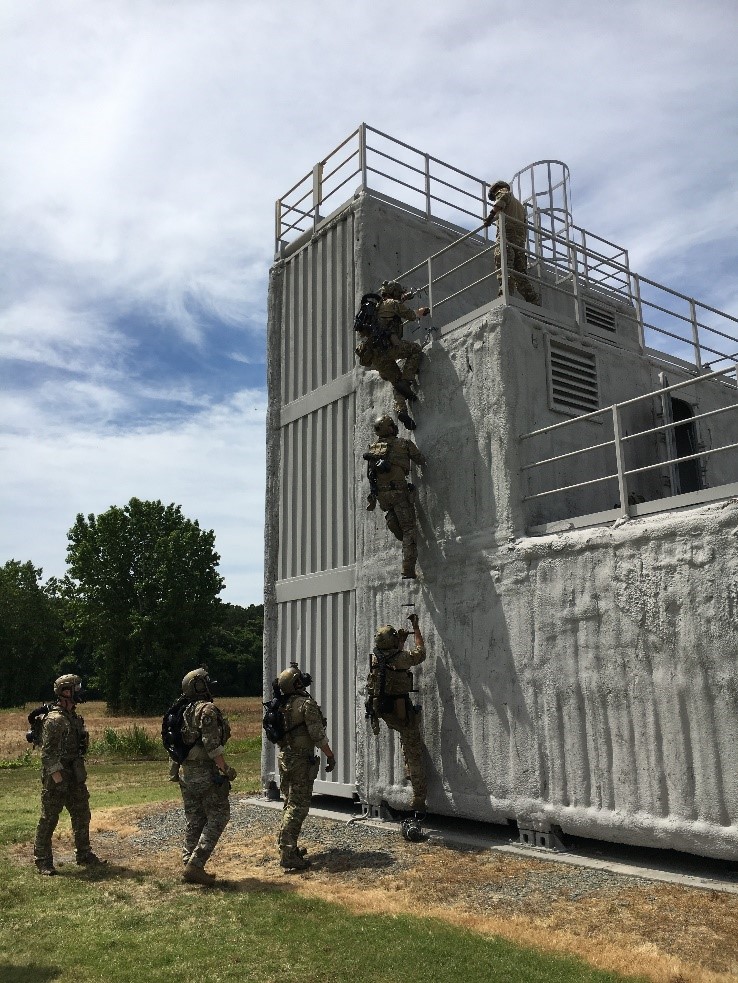The Coast Guard’s Maritime Security Response Team (MSRT) is a tactical unit that specializes in maritime counterterrorism and high-risk law enforcement operations, boarding and securing vessels held by terrorists or criminal groups at home and abroad. Some of these operations involve chemical, biological, radiological and nuclear (CBRN) threats and require protective equipment, including air-purifying respirator (APR) masks.
The Coast Guard asked S&T to assist in meeting a need to reduce the discomfort of wearing APRs by MSRT teams because discomfort adds to physical stress, which may impede endurance. To resolve this issue, S&T enlisted the U.S. Army Combat Capabilities Development Command’s Chemical Biological Center (CBC) to assess existing Powered-air Purifying Respirators (PAPRs) and recommend models that would be a better fit with MSRT’s current masks, literally and figuratively.
The physical stress of rapidly moving through ships, clearing spaces, and potentially dealing with armed suspects can significantly raise respiration and heart rate,” said Daniel Moose, Technical Director for MSRT East. “We wanted a system that would minimize some of the negative physiological impacts during heavy exertion and extended missions—lower the respiration rate and make it easier to breathe through the filters in a regular protective mask.”
S&T began assessing PAPRs in 2017 and concluded its work in September 2019. During this time, S&T invested subject matter expertise and conducted user tests for MSRT’s CBRN missions. In June 2019, S&T and CBC assessed the performance of PAPR equipment at MSRT East in Chesapeake, Virginia, where MSRT operators tested products in simulated operational settings to select the most suitable one for their missions.
“MSRT members are responsible for keeping the maritime environment safe and are required to be capable of operating in a CBRN environment,” said Dr. Don Bansleben, S&T Program Manager for the PAPR Assessment. “To perform their job most effectively, they need to be outfitted with high quality personal protective equipment, such as a respiratory protective system that minimizes stress and exertion, while also protecting against a range of contaminants.”
How a better PAPR can help the Coast Guard
Filters in PAPR systems protect against hazardous CBRN substances in the air via an activated carbon filter and a High-Efficiency Particulate Air, or HEPA, filter. PAPR takes in atmospheric air via a motor, filters it and blows it across the inside of the mask worn by MSRT operators.
Even at peak performance, when MSRT operators have to climb or run onto ships while carrying 70-pounds of equipment including weapons, armor, and detection equipment, physical discomfort can affect their intense focus on the mission at hand and make their work more difficult. Physical exertion leads to sweating, which can fog up the visor on the protective mask.
“Not being able to see clearly is more dangerous for them, especially if an adversary is shooting at them,” Bansleben said. “You want to be really focused on what you’re trying to do and not worrying that you are starting to feel weak, hot or tired. Effective PAPR systems provide a continuous stream of cool, filtered air across your face, so it keeps you cool. This helps MSRT operators maintain their physical stamina to safely finish their mission.”
Testing PAPR systems
Many vendors make PAPRs for both military and industrial applications. S&T together with CBC evaluated currently existing respirator technology for its suitability for use in the maritime environment and ability to work in conjunction with MSRT’s current protective masks.
The Coast Guard selected two Avon Industries products, the EZAir+ and MP-PAPR systems (wearable like backpacks with a flexible hose) and worked with S&T and CBC to test them and provide the best one to MSRT operators. The main purpose of the tests, which took place in January-June 2019, was to see whether these respirators meet manufacturer specifications and Coast Guard requirements.
“S&T and the Coast Guard, with the help of the U.S. Army’s CBC in Edgewood, performed controlled lab testing to ensure that these systems are durable, reliable, simple to operate, and that they’ll stand up in the environments that we would wear them in,” said Moose.
For example, they tested the airflow to make sure it matches what the manufacturer states. They also tested the PAPR systems in a simulated maritime environment by spraying them multiple times with salt fog spray and letting them dry, and then taking the equipment apart to check for corrosion. Another test involved dropping the systems from 10-13 feet in the air onto hard surfaces and checking if the systems were still functioning.
“They need to withstand exposure to salt water for long periods of time, to high temperatures, low temperatures, and they must be durable enough for the bangs and drops that they would be exposed to when our operators are using them,” Moose said.
Then in June 2019, S&T and CBC tested the two systems at MSRT East in a simulated mission to make sure the respirators are compatible with the protective masks and work well with the equipment the MSRT operators wear.
The MSRT operators, while carrying guns and other equipment, descended and climbed ropes, climbed stairs, threw rope ladders on a structure that imitates a ship and ascended them. Finally, they provided feedback.
“The Avon MP-PAPR resolves most of the sweat buildup and fogging inside the mask,” said Moose. “It makes it much more comfortable for the members to do their job even when they have to negotiate a lot of stairs and run up and down ships. S&T and the Army’s CBC were extremely helpful in facilitating a lot of the testing.”
Future outlook
The results, both qualitative and quantitative, were incorporated in a report for the Coast Guard and supported acquisition of the Avon MP-PAPR system for use by all MSRT teams for their missions. After the vendor made enhancements, the chosen system underwent successful final assessment in October at the MSRT Headquarters. Based on findings of the technology assessments, the DHS Countering Weapons of Mass Destruction Office is procuring these devices for the Coast Guard.
“We are hoping in the beginning of 2020 to begin fielding the new PAPRs to all our members,” Moose said. “This great collaborative effort that S&T led will help our operators be more effective at doing their job by increasing endurance and decreasing some of the physical stress they have to endure.”
Original post https://alertarticles.info



